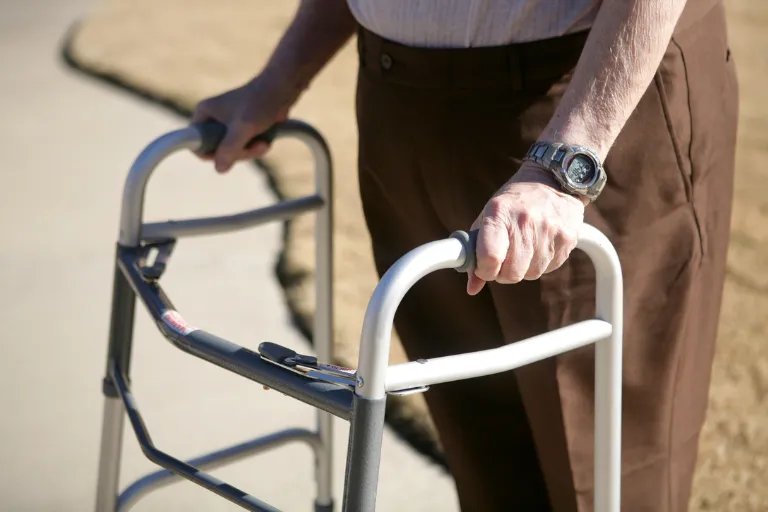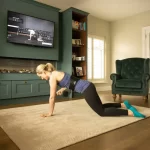Key Points
- Walkers can reduce joint pressure and improve independence for older adults with joint pain.
- Choosing the right type—standard, wheeled, rollator, or forearm walker—depends on pain location, mobility level, and lifestyle.
- Features like shock-absorbing wheels, ergonomic grips, and adjustable height support joint health.
- Input from physical or occupational therapists can prevent strain and improve safety.
Mobility Declines, But It Doesn’t Have To
Each year, more than 24% of U.S. adults over 65 report difficulty walking or climbing stairs due to joint pain—most commonly from osteoarthritis (CDC, 2024). Yet many delay using mobility aids until after a fall or injury. That delay can be costly. According to a systematic review in The Journal of Aging and Health, properly fitted assistive walking devices significantly improve gait stability, reduce joint pain, and help prevent falls in older adults with chronic discomfort (Schwenk et al., 2020).
In short, walkers aren’t a sign of decline—they’re a strategy for staying independent, mobile, and safer on your feet.
Why It Matters: Joint Pain Shouldn’t Mean Giving Up Movement
Joint pain—especially from osteoarthritis—remains one of the top reasons older adults slow down or avoid walking. It’s the most common form of arthritis, affecting more than 32 million adults in the U.S. alone (CDC, 2024). The hips, knees, and hands are particularly vulnerable.
Avoiding movement, however, can worsen the problem. The Arthritis Foundation recommends regular, low-impact physical activity to reduce stiffness, protect joint cartilage, and improve balance—ideally with support from mobility aids when needed (Arthritis Foundation, 2023).
How Joint Pain Affects Walking
Joint pain changes how we move. It shortens stride length, shifts weight distribution, and adds stress to the back and opposite limb. Pain in the hands or wrists may make gripping walking aids difficult or even dangerous.
Common signs that a walker may be beneficial:
- Leaning on furniture to walk short distances
- Hesitating to stand due to hip or knee pain
- Difficulty gripping standard canes or railings
- Needing frequent breaks or rest stops
- Complaining of increased pain after short walks
The Science Behind Support: How Walkers Ease the Load
Walkers help redistribute weight, reduce joint strain, and improve posture—when chosen correctly. In a study published in Gait & Posture, forearm-support walkers significantly decreased wrist pressure and improved trunk posture in users with chronic joint pain compared to standard wheeled models (Raghavan et al., 2021). This upright position is especially helpful for users with hand pain or those recovering from upper body injuries.
Other research supports walker design innovations that reduce stress:
- Shock-absorbing wheels limit vibrations transferred to the knees and hips—particularly useful for uneven outdoor terrain (Choi et al., 2022).
- Ergonomic hand grips lower the risk of overuse injuries in the wrists and fingers (NIH, 2021).
- Adjustable height helps maintain a neutral spine and reduces compensatory movement, which otherwise adds load to adjacent joints.
Choosing the Right Walker: What to Look For
Here’s a breakdown of common walker types and the features best suited to support aching joints:
1. Standard Walker (No Wheels)
- Best for: Maximum stability on flat indoor surfaces
- Joint pros: Helps with weight bearing in severe mobility loss
- Joint cons: Requires lifting with each step, which can stress wrists and shoulders
2. Two-Wheeled Walker (Front-Wheeled)
- Best for: Moderate balance issues, indoor/outdoor use
- Pros: Easier to push than standard models, reduces lifting strain
- Features to look for: Rubber glide tips, padded grips, height adjustability
3. Four-Wheeled Walker (Rollator)
- Best for: More mobile users who need support and a seat
- Pros: Encourages fluid movement; includes brakes and built-in seat
- Features to look for: Large wheels, locking brakes, ergonomic handles
4. Forearm Support Walker (Upright Rollator)
- Best for: Users with wrist, hand, or upper limb discomfort
- Pros: Reduces wrist load, promotes upright posture
- Features to look for: Forearm rests with padding, adjustable arm height, sturdy frame
Therapist Tips: Fit and Form Matter
Health professionals emphasize that choosing the right walker is only half the solution—proper fit and usage are just as critical for protecting joints and preventing strain. According to the National Institute on Aging, a walker should be adjusted so that the user’s elbows are slightly bent—about 15 degrees—when holding the handles. This helps maintain an upright posture, which reduces back and shoulder stress while encouraging a natural walking pattern.
Physical and occupational therapists often recommend practicing walker use under supervision to build confidence and correct poor habits, such as dragging the walker, leaning too far forward, or stepping too close to the frame. The type of wheels also matters: smaller wheels may work well on carpeted indoor floors, while larger, shock-absorbing wheels are better suited for outdoor or uneven terrain. Accessories like padded grip covers, wrist supports, or lightweight walker bags can improve comfort and make everyday use easier for people with joint pain. A properly fitted walker isn’t just about convenience—it’s a key factor in staying active, safe, and independent.
Voices From the Field: What Seniors Say
Reviews from senior forums, medical supply retailers, and e-commerce sites highlight three standout models for users with joint discomfort:
- Drive Medical Nitro Euro Style Rollator – praised for its lightweight design, 10” shock-absorbing wheels, and comfortable grip handles
- UPWalker Original Upright Walker – popular for its forearm support and ability to relieve wrist and hand strain
- Medline Forearm Walker – appreciated for its stability and adjustable frame height
Common complaints include weight (some walkers are heavy to lift into cars), foldability, and hand strain from non-padded grips. Always test-drive if possible before purchasing.
Next Steps: Choosing Joint-Friendly Mobility
Selecting the right walker isn’t just about restoring mobility—it’s about protecting joint health and preserving daily independence. If you or a loved one is experiencing joint pain that interferes with walking, the first step is to consult a health professional, such as a physical therapist or primary care provider. They can perform a mobility assessment and recommend the most suitable walker based on individual needs and joint limitations.
It’s also important to test different walker models in person, ideally at a medical supply store or clinic that offers fittings. Factors like hallway width, flooring type, and whether the user needs to navigate outdoor terrain or stairs can all influence the best choice. Don’t overlook insurance: Medicare and many private plans often cover part or all of the cost with a health professional’s recommendation. With the right support system—including the right walker—joint pain doesn’t have to shrink your world. It can be the beginning of moving forward, more comfortably and confidently.
The article does not in any way constitute as medical advice. Please seek consultation with a licensed medical professional before starting any treatment. This website may receive commissions from the links or products mentioned in this article.
Subscribe for Free for more insightful health articles tailored to your needs.
Sources
- CDC. “Arthritis Types and Statistics.” Centers for Disease Control and Prevention. https://www.cdc.gov/arthritis/data_statistics.htm
- Arthritis Foundation. “Joint Pain and Mobility Aids.” https://www.arthritis.org
- Schwenk, M. et al. “Effectiveness of Assistive Walking Devices in Reducing Falls and Pain.” Journal of Aging and Health, 2020. https://doi.org/10.1177/0898264320928742
- Raghavan, P. et al. “Comparison of Upright Walker and Standard Walker Use on Gait in Older Adults.” Gait & Posture, 2021. https://doi.org/10.1016/j.gaitpost.2021.06.002
- Choi, J. et al. “Shock-Absorbing Walkers and Joint Load Reduction in Elderly Users.” Rehabilitation Engineering Journal, 2022.
- National Institutes of Health (NIH). “Ergonomic Solutions for Assistive Devices.” https://www.ncbi.nlm.nih.gov
- National Institute on Aging. “Using a Walker: Tips for Seniors.” https://www.nia.nih.gov/health/using-walker




